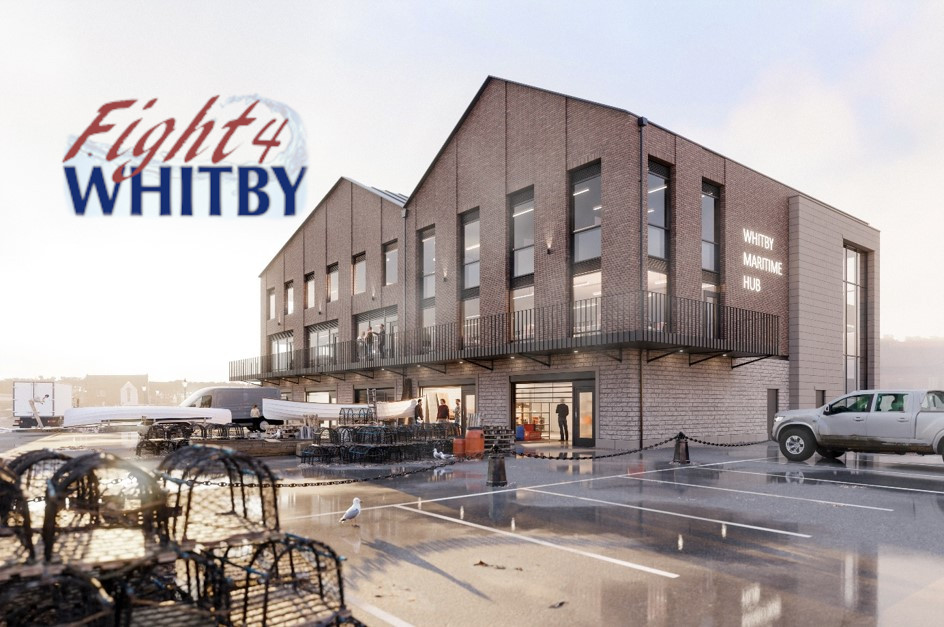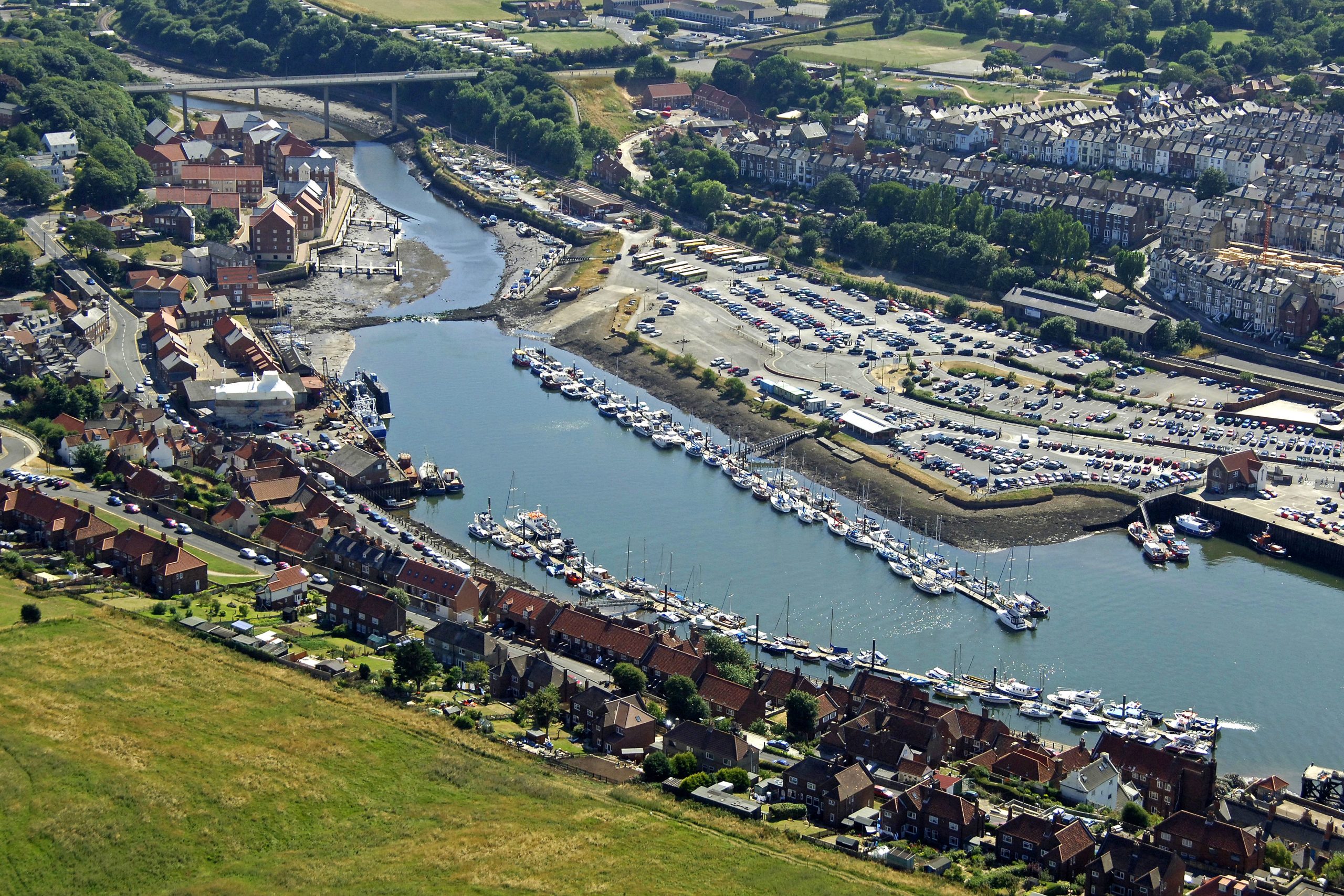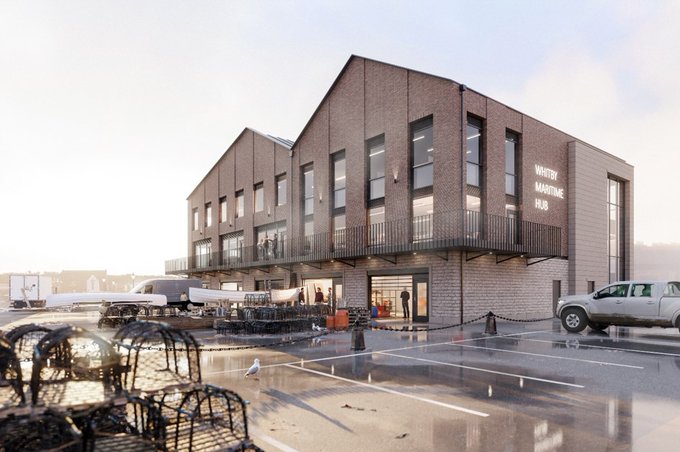One project on the Whitby Town Deal is for the Old Town Hall and Marketplace. Planning permission was granted by NYC, despite an objection from the Georgian Group. NYC have conveniently removed all comments off their website, so we will reproduce this one here.
To: Planning Services (SCA)
Subject: Case ZF23/00616/LB – Old Town Hall, Church Street, Whitby
Dear Daniel Metcalfe,
The Georgian Group have been notified by a third party of application ZF23/00616/LB for a scheme of works at Grade II* listed Old Town Hall, Church Street, Whitby. The Group raises no objection in principle to the repair and restoration of the building, however we register the following concerns.
Old Town Hall was built 1788 to replace an earlier toll-booth structure on the site. It is a handsome example of a townhall with GF market undercroft and FF meeting room/hall.
The Proposals are for a series of internal and external repair, refurbishment and renovation works including removal of stud walls, doors and fireplace, and replacement/repairs to windows. It is additionally proposed to install a sink within the central rotunda and to undertake a range of works to the surrounding marketplace.
Notification
The Group registers significant concerns that we were not formally notified of this application by North Yorkshire Council and were only made aware of its existence by a third party. We advise that this is the second application in recent months (from the former Scarborough BC LPA area) in which The Georgian Group has only become aware via third party notification.
We therefore take this opportunity to remind the LPA of the legal duty that local planning authorities have to notify the National Amenity Societies in the following cases (Section 4b, The Direction 2021): for works for the demolition of a listed building [Grades II, II* and I]; or for works for the alteration of a listed building [Grades II, II* and I] which comprise or include the demolition of any part of that building.
We advise that in future the National Amenity Societies should be formally notified of all Listed Building Consent applications which meet the abovementioned criteria through direct e-mail notification to casework@jcnas.org.uk.
Advice and Recommendations
Removal of Stud Wall, Door, and Fire surround
The Group registers significant concerns that it is proposed to remove the lath and plaster partition wall and to remove 2no. six-panel doors and a central fire surround from the east end of the FF. The age and condition of these features is entirely undiscussed in the Heritage Statement however we advise that the position and symmetry of the doorways and fireplace suggests they are likely to be part of the original design of the building. It is however unclear if the 6 panel doors or fire surround are historic.
We advise that without further discussion of the age or significance of these fixtures the application fails to meet the requirements of NPPF (2021) paragraph 194 viz. In determining applications, local planning authorities should require an applicant to describe the significance of any heritage assets affected, including any contribution made by their setting. The level of detail should be proportionate to the assets’ importance and no more than is sufficient to understand the potential impact of the proposal on their significance. As a minimum the relevant historic environment record should have been consulted and the heritage assets assessed using appropriate expertise where necessary.
We further advise that the lack of specific information may also prevent the LPA from fulfilling their responsibility under NPPF paragraph 195 viz. Local planning authorities should identify and assess the particular significance of any heritage asset that may be affected by a proposal (including by development affecting the setting of a heritage asset) taking account of the available evidence and any necessary expertise. They should take this into account when considering the impact of a proposal on a heritage asset, to avoid or minimise any conflict between the heritage asset’s conservation and any aspect of the proposal. The Group therefore queries how it has been determined that these features – which are potentially original to the building, have been determined to be only of ‘medium value’ in the Heritage Statement.
We advise that as the arrangement of doors and fireplace is likely original to the building that it must be considered to be of high significance with strong evidential and aesthetic value contributing to the overall special architectural significance of the building as a Grade II* listed heritage asset. The proposed interventions to disrupt this symmetry and ‘strip out’ probable original built fabric would therefore cause significant and irreversible harm to the historic fabric and character of the building. This harm would be increased if the doors and/or fire surround are also historic.
We therefore advise that the proposals fail to meet the requirements of NPPF paragraph 199 viz. When considering the impact of a proposed development on the significance of a designated heritage asset, great weight should be given to the asset’s conservation (and the more important the asset, the greater the weight should be). This is irrespective of whether any potential harm amounts to substantial harm, total loss or less than substantial harm to its significance.
We further advise that the justification for the proposed works is neither clear nor convincing and the proposal thereby fails to meet the requirements of NPPF paragraph 200. Viz. Any harm to, or loss of, the significance of a designated heritage asset (from its alteration or destruction, or from development within its setting), should require clear and convincing justification. The Group recommends that the applicant provides further information regarding the age, condition and significance of these fixtures and should revise the application to retain the existing designed arrangement of the room.
Installation of kitchenette and WC
The Group also objects to the proposed installations of a kitchenette and WC, we advise that the alterations would cause considerable harm to the designed composition of the FF room, altering the historic room volume and disrupting the symmetry of the space. This harm would be in addition to the proposed stripping out works discussed above.
We therefore advise that this proposal thereby again fails to meet the requirements of NPPF paragraphs 199 and 200.
Repairs and Works to Masonry, Windows, Bellcote and Roof
The Group welcomes the proposed repairs and conservation works to the masonry, windows, bellcote, and roof of the Old Town Hall. We strongly recommend however that the applicant submits a full method statement and schedule of works explaining and specifying details of the proposed materials and scope of works. We advise that these should be submitted for assessment and approval prior to LBC being determined.
Relationship to Application ZF23/00618/LB
The Group raises significant concerns that elements of this application are dependent on the success of application ZF23/00618/LB to enclose the GF of the old Town Hall. We advise that The Group strongly objects in principle to the proposal to enclose the GF and we therefore decline to comment on the proposed GF works within this application which depend on the proposed enclosure.
The Group advises that the entanglement of these two applications jeopardises the proposed necessary repairs and conservation works to masonry and windows of The Old Town Hall which we overall welcome.
We strongly recommend that this application should be revised so that it is not dependant on the success of ZF23/00618/LB. We therefore recommend that the applicant should revise this application to include only the proposed necessary masonry and window repairs/conservation works.
Conclusion
When making a decision on all listed building consent applications or any decision on a planning application for development that affects a listed building or its setting, a local planning authority must have special regard to the desirability of preserving the building or its setting or any features of special architectural or historic interest which it possesses. Preservation in this context means not harming the special interest of the building, as opposed to keeping it utterly unchanged. This obligation, found in sections 16 and 66 of the Planning (Listed Buildings and Conservation Areas) Act 1990 (1), applies to all decisions concerning listed buildings. Under section 72(1) of the Planning (Listed Buildings and Conservation Areas) Act 1990 they also have a duty to pay special attention to the desirability of preserving or enhancing the character or appearance of conservation areas.
The Group must advise that the proposed scheme of works would cause significant and irreversible harm to the special architectural and historical significance of The Old Town Hall as a Grade II* listed heritage asset.
We recommend that the advice contained in this letter is considered in combination with that which we have offered for application ZF23/00618/LB as a closely related application. The Georgian Group would be pleased to meet with the applicant to discuss these proposals further in the interest of securing a sympathetic and sustainable future for The Old Town Hall.
The Group recommends that the applicant withdraws this application and revises it to address the abovementioned comment, concerns, and objections. If the applicant is unwilling to do so, Listed Building Consent should be refused.
Yours sincerely,
Conservation Adviser, Georgian Group – Northern England
NYC did not include this advice in the Officer’s report despite not posting their report until after this response was on the website.
Make your own judgements on how well the NYC planning process is amply considering expert advice.
Addendum
For reference, there was an associated planning application to surround the Town Hall in glass screens. The Georgian Group were similarly not added as a consultee, and they were notified by a third party. Their comments on that application were of a similar nature. Note that this planning application is still in the planning system, and not yet removed, despite NYC Alex Richards implying that it was removed when attending a WCN meeting.
Dear Daniel Metcalfe,
The Georgian Group have been notified by a third party of application ZF23/00618/LB for a scheme of works at Grade II* listed Old Town Hall, Church Street, Whitby. We object to the proposals on the following grounds.
Old Town Hall was built 1788 to replace an earlier toll-booth structure on the site. It is a handsome example of a townhall with GF market undercroft and FF meeting room/hall.
The Group advises that the below comments should be read in conjunction with those offered for application ZF23/00616/LB.
The proposals are to enclose the GF market undercroft by installing glazing between the supporting columns.
Notification
The Group registers significant concerns that we were not formally notified of this application by North
Yorkshire Council and were only made aware of its existence by a third party. We advise that this is the
third application in recent months (from the former Scarborough BC LPA area) in which The Georgian Group has only become aware via third party notification.
We therefore take this opportunity to remind the LPA of the legal duty that local planning authorities have to notify the National Amenity Societies in the following cases (Section 4b, The Direction 2021): for works for the demolition of a listed building [Grades II, II* and I]; or for works for the alteration of a listed building [Grades II, II* and I] which comprise or include the demolition of any part of that building.
In this instance we would particularly consider the proposals to lift the stone slab floor to constitute notifiable demolition.
We advise that in future the National Amenity Societies should be formally notified of all Listed Building Consent applications which meet the abovementioned criteria through direct e-mail notification to casework@jcnas.org.uk .
Advice and Recommendations
In the interest of brevity, The Group echoes and supports all of the comments offered by Historic England in their letter of 21st June 2023. We particularly emphasise the advice that ‘The enclosure of the ground floor external space and its conversion into an internal space, which has always been designed to be open, will take away the open heart and permeability of the building. It will fundamentally change house the building is seen, experienced, and appreciated.’. We likewise emphasise significant concerns over the harm which would be caused to the fabric of the historic building by the installation of the proposed screens.
The Group therefore advises in concert with Historic England that the proposals fail to meet the requirements of NPPF (2021) paragraphs 199 and 200.
Conclusion
When making a decision on all listed building consent applications or any decision on a planning application for development that affects a listed building or its setting, a local planning authority must have special regard to the desirability of preserving the building or its setting or any features of special architectural or historic interest which it possesses. Preservation in this context means not harming the special interest of the building, as opposed to keeping it utterly unchanged. This obligation, found in sections 16 and 66 of the Planning (Listed Buildings and Conservation Areas) Act 1990 (1), applies to all decisions concerning listed buildings. Under section 72(1) of the Planning (Listed Buildings and Conservation Areas) Act 1990 they also have a duty to pay special attention to the desirability of preserving or enhancing the character or appearance of conservation areas.
The Group must advise that the proposed scheme of works would cause significant and irreversible harm to the special architectural and historical significance of The Old Town Hall as a Grade II* listed heritage asset.
The Group therefore recommends that the applicant withdraws this application. If the applicant is unwilling to do so, Listed Building Consent should be refused.
Yours sincerely,
Conservation Adviser, Georgian Group – Northern England




